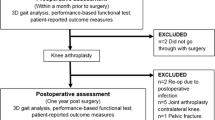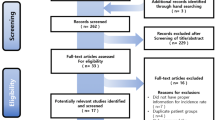Abstract
Purpose
Knee pain and disability can persist following knee replacement surgery which may place patients at increased risk of falls. This study investigated the falls risk and the occurrence of falls of people with knee osteoarthritis (OA) before and at 12 months following knee replacement surgery.
Method
Thirty-five patients with knee OA were tested prior to undergoing knee replacement surgery and at 12 months following surgery using the short form Physiological Profile Assessment, which incorporates tests of vision, lower limb proprioception, knee extension strength, reaction time and postural sway. Physical activity, number of falls, fear of falling, pain, disability and health-related quality of life were also assessed.
Results
No significant differences were found between the number of falls pre- and post-surgery (n.s.), with 48.5 and 40% reporting at least one fall in the 12 months before and following the surgery, respectively. Improvements in knee strength, reaction time and fear of falling were evident following surgery, with no improvement in lower limb proprioception. Self-reported pain, function and stiffness were significantly improved, but health-related quality of life deteriorated following the surgery.
Conclusion
The number of falls experienced following knee replacement surgery remained relatively high, which may be attributed to the persistence of impaired lower limb proprioception. Although knee replacement surgery improves function and alleviates pain, people who undergo this procedure may need to engage in rehabilitation following the surgery to reduce the risk of falling.
Level of evidence
Therapeutic study investigating the result of treatment on patient outcomes, Level IV.

Similar content being viewed by others
References
Australian Orthopaedic Association National Joint Replacement Registry (2010) Annual report. Adelaide. http://www.dmac.adelaide.edu.au/aoanjrr/documents/aoanjrrreport_2010.pdf
Baker PN, van der Meulen JH, Lewsey J, Gregg PJ (2007) The role of pain and function in determining patient satisfaction after total knee replacement. Data from the national joint registry for England and Wales. J Bone Jt Surg Br 89:893–900
Bellamy N (1989) Pain assessment in osteoarthritis: experience with the WOMAC osteoarthritis index. Semin Arthritis Rheum 18:14–17
Brander VA, Stulberg SD, Adams AD, Harden RN, Bruehl S, Stanos SP, Houle T (2003) Predicting total knee replacement pain: a prospective, observational study. Clin Orthop Relat Res 416:27–36
Campbell AJ, Borrie MJ, Spears GF (1989) Risk factors for falls in a community based prospective study of people 70 years and older. J Gerontol 44:M112–M117
Chiba H, Ebihara S, Tomita N, Sasaki H, Butler JP (2005) Differential gait kinematics between fallers and non-fallers in community dwelling elderly people. Geriatr Gerontol Int 5:127–134
Cushnaghan J, Bennett J, Reading I, Croft P, Byng P, Cox K, Dieppe P, Coggon D, Cooper C (2009) Long-term outcome following total knee arthroplasty: a controlled longitudinal study. Ann Rheum Dis 68:642–647
Delbaere K, Hauer K, Lord SR (2009) Evaluation of the incidental and planned activity questionnaire (IPAQ) for older people. Br J Sports Med 44:1029–1034
Dolinis J, Harrison JE, Andrews GR (1997) Factors associated with falling in older Adelaide residents. Aust N Z J Public Health 21:462–468
Foley SJ, Lord SR, Srikanth V, Cooley H, Jones G (2006) Falls risk is associated with pain and dysfunction but not radiographic osteoarthritis in older adults: Tasmanian older adult cohort study. Osteoarthr Cartil 14:533–539
Frost H, Lamb SE, Robertson S (2002) A randomized controlled trial of exercise to improve mobility and function after elective knee arthroplasty. Feasibility, results and methodological difficulties. Clin Rehabil 16:200–209
Fuchs S, Thorwesten L, Niewerth S (1999) Proprioceptive function in knees with and without total knee arthroplasty. Am J Phys Med Rehabil 78:39–45
Hawker G, Wright J, Coyte P, Paul J, Dittus R, Croxford R, Katz B, Bombardier C, Heck D, Freund D (1998) Health-related quality of life after knee replacement. J Bone Jt Surg Am 80:163–173
Hawthorne G, Richardson J, Osborne R (1999) The assessment of quality of life (AQoL) instrument: a psychometric measure of health-related quality of life. Qual Life Res 8:209–224
Isaac SM, Barker KL, Danial IN, Beard DJ, Dodd CA, Murray DW (2007) Does arthroplasty type influence knee joint proprioception? A longitudinal prospective study comparing total and unicompartmental arthroplasty. Knee 14:212–217
Kempen GI, Yardley L, van Haastregt JC, Zijlstra GA, Beyer N, Hauer K, Todd C (2008) The short FES-I: a shortened version of the falls efficacy scale-international to assess fear of falling. Age Ageing 37:45–50
Lamb SE, Jorstad-Stein EC, Hauer K, Becker C (2005) Development of a common outcome data set for fall injury prevention trials: the prevention of falls network Europe consensus. J Am Geriatr Soc 53:1618–1622
Lawlor DA, Patel R, Ebrahim S (2003) Association between falls in elderly women and chronic diseases and drug use: cross sectional study. BMJ 327:712–717
Leveille SG, Bean J, Bandeen-Roche K, Jones R, Hochberg M, Guralnik JM (2002) Musculoskeletal pain and risk for falls in older disabled women living in the community. J Am Geriatr Soc 50:671–678
Leveille SG, Jones RN, Kiely DK, Hausdorff JM, Shmerling RH, Guralnik JM, Kiel DP, Lipsitz LA, Bean JF (2009) Chronic musculoskeletal pain and the occurrence of falls in an older population. JAMA 302:2214–2221
Levinger P, Menz HB, Wee E, Feller JA, Bartlett JR, Bergman NR (2011) Physiological risk factors for falls in people with knee osteoarthritis before and early after knee replacement surgery. Knee Surg Sports Traumatol Arthrosc 19:1082–1089
Lord SR, Clark RD, Webster IW (1991) Physiological factors associated with falls in an elderly population. J Am Geriatr Soc 39:1194–1200
Lord SR, McLean D, Stathers G (1992) Physiological factors associated with injurious falls in older people living in the community. Gerontology 38:338–346
Lord SR, Menz HB, Tiedemann A (2003) A physiological profile approach to falls risk assessment and prevention. Phys Ther 83:237–252
Lord SR, Ward JA, Williams P, Anstey KJ (1994) Physiological factors associated with falls in older community-dwelling women. J Am Geriatr Soc 42:1110–1117
March LM, Bagga H (2004) Epidemiology of osteoarthritis in Australia. Med J Aust 180:S6–S10
Meier W, Mizner RL, Marcus RL, Dibble LE, Peters C, Lastayo PC (2008) Total knee arthroplasty: muscle impairments, functional limitations, and recommended rehabilitation approaches. J Orthop Sports Phys Ther 38:246–256
Mizner RL, Petterson SC, Snyder-Mackler L (2005) Quadriceps strength and the time course of functional recovery after total knee arthroplasty. J Orthop Sports Phys Ther 35:424–436
Moreland JD, Richardson JA, Goldsmith CH, Clase CM (2004) Muscle weakness and falls in older adults: a systematic review and meta-analysis. J Am Geriatr Soc 52:1121–1129
Morris M, Osborne D, Hill K, Kendig H, Lundgren-Lindquist B, Browning C, Reid J (2004) Predisposing factors for occasional and multiple falls in older Australians who live at home. Aust J Physiother 50:153–159
Nahit ES, Silman AJ, Macfarlane GJ (1998) The occurrence of falls among patients with a new episode of hip pain. Ann Rheum Dis 57:166–168
O’Loughlin JL, Robitaille Y, Boivin JF, Suissa S (1993) Incidence of and risk factors for falls and injurious falls among the community-dwelling elderly. Am J Epidemiol 137:342–354
Rossat A, Fantino B, Nitenberg C, Annweiler C, Poujol L, Herrmann FR, Beauchet O (2010) Risk factors for falling in community-dwelling older adults: which of them are associated with the recurrence of falls? J Nutr Health Aging 14:787–791
Sturnieks DL, Tiedemann A, Chapman K, Munro B, Murray SM, Lord SR (2004) Physiological risk factors for falls in older people with lower limb arthritis. J Rheumatol 31:2272–2279
Swinkels A, Newman JH, Allain TJ (2009) A prospective observational study of falling before and after knee replacement surgery. Age Ageing 38:175–181
Valtonen A, Poyhonen T, Heinonen A, Sipila S (2009) Muscle deficits persist after unilateral knee replacement and have implications for rehabilitation. Phys Ther 89:1072–1079
Walsh M, Woodhouse LJ, Thomas SG, Finch E (1998) Physical impairments and functional limitations: a comparison of individuals 1 year after total knee arthroplasty with control subjects. Phys Ther 78:248–258
Williams SB, Brand CA, Hill KD, Hunt SB, Moran H (2010) Feasibility and outcomes of a home-based exercise program on improving balance and gait stability in women with lower-limb osteoarthritis or rheumatoid arthritis: a pilot study. Arch Phys Med Rehabil 91:106–114
Wolfson L, Judge J, Whipple R, King M (1995) Strength is a major factor in balance, gait, and the occurrence of falls. J Gerontol A Biol Sci Med Sci 50. Spec no: 64-67
Woolf AD, Pfleger B (2003) Burden of major musculoskeletal conditions. Bull World Health Organ 81:646–656
Acknowledgments
This study was funded by the Clive and Vera Ramaciotti Foundation and the Arthritis Australia. HBM is currently a National Health and Medical Research Council fellow (Clinical Career Development Award, ID: 433049). The authors would like to thank Margaret Perrott for her assistance in the data collection.
Author information
Authors and Affiliations
Corresponding author
Rights and permissions
About this article
Cite this article
Levinger, P., Menz, H.B., Morrow, A.D. et al. Lower limb proprioception deficits persist following knee replacement surgery despite improvements in knee extension strength. Knee Surg Sports Traumatol Arthrosc 20, 1097–1103 (2012). https://doi.org/10.1007/s00167-011-1710-y
Received:
Accepted:
Published:
Issue Date:
DOI: https://doi.org/10.1007/s00167-011-1710-y




